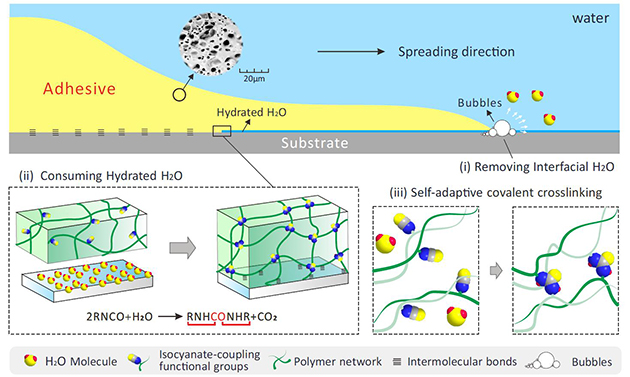Wet adhesion plays an important role in fields such as mechanical engineering, marine technology and medical science. However, the presence of water molecules during solid-solid interfacial aqueous bonding can easily lead to bond failure, mainly because interfacial water hinders the contact between the adhesive and the substrate and the formation of intermolecular interactions. For the removal of interfacial water, researchers have made various attempts, such as interfacial water absorption, hydrophobic repulsion, and extrusion, but these methods cannot achieve complete removal of interfacial water, and it is difficult to ensure high-performance adhesion at the interface.
Recently, the team of Zhou Feng, a researcher at the State Key Laboratory of Solid Lubrication, Lanzhou Institute of Chemical Physics, Chinese Academy of Sciences, proposed a multi-scale deep dehydration mechanism based on physicochemical coupling, and developed an underwater self-adaptive enhanced glue based on this mechanism. Adhesive, which achieves strong underwater bonding in harsh environments (high/low pH, seawater), and has been applied in underwater sand fixation, underwater repair and adhesion failure detection. Related research results were published in PNAS.
The physicochemically coupled multiscale dehydration mechanism includes the physical replacement of interfacial water at the millimeter scale by virtue of excellent wettability. Through the gas film formed by the chemical reaction between the isocyanate segment in the adhesive and water, the physical shielding of interfacial water at the micron scale is realized, and the consumption of interfacial bound water is realized at the molecular scale. This series of instantaneous and spontaneous contact, spreading, wetting, and gelation processes of the underwater self-adaptively reinforced adhesive achieves a strong bond to the substrate surface.
The underwater self-adaptive enhanced adhesive exhibits excellent underwater adhesion performance and wide substrate applicability, and achieves high-performance adhesion from inorganic to organic material surfaces in freshwater, seawater and water environments with different pHs. Its peak value exceeds 1600kPa. Good adhesion performance and self-adaptive reinforcement without external energy input make the underwater self-adaptive reinforced adhesive show great application potential in underwater sand fixation, underwater repair and even adhesion failure detection.
In order to study the mechanism of the influence of interfacial water on underwater adhesion in the process of solid-solid adhesion, the researchers proposed a multi-scale dehydration mechanism coupled with physicochemistry, which realized the deep removal of water at the adhesion interface and shielded the water from interfacial adhesion. Influence, combined with the self-adaptive gelation of the adhesive, obtains high-strength adhesion under water. This physically and chemically coupled multiscale deep dehydration mechanism has certain guiding significance for the design of underwater adhesive materials.

Schematic diagram of underwater adhesive dehydration process and self-adaptive adhesion



 微信扫一扫打赏
微信扫一扫打赏
